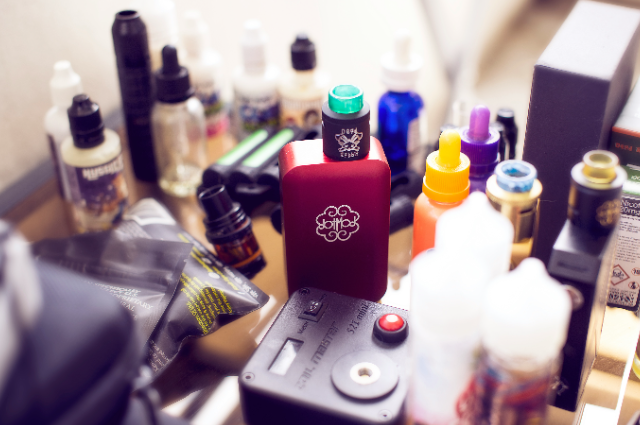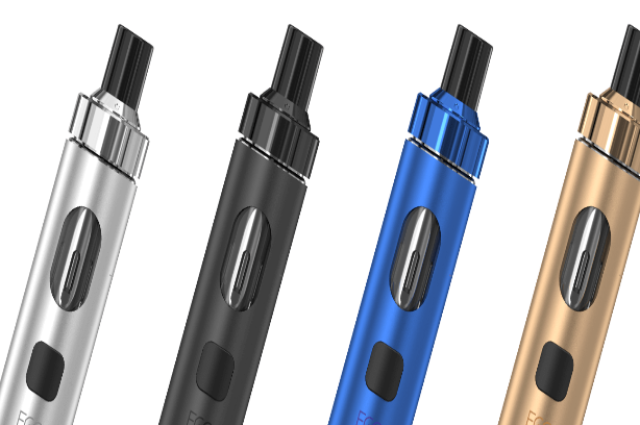
Photo by Antonin FELS on Unsplash
Introduction
Over a period of less than ten years, electronic cigarettes known as electronic nicotine delivery systems (ENDS) have significantly reshaped the consumption patterns of nicotine products among teenagers and young adults. Initially introduced as a strategy to reduce harm and aid in quitting smoking for adult cigarette users; e-cigarettes and similar vaping devices have quickly gained popularity among young people worldwide. This surge in popularity can be attributed to various factors such as aggressive marketing targeting youth by e-cigarette companies, the ease of access to vaping products, their affordability, the perception of lower risk compared to traditional cigarettes, appealing flavours , designs specifically tailored to attract younger audiences and the strong delivery of nicotine resulting in intense psychoactive effects.
Despite the wide range of e-cigarettes and vaping products available, many of them operate on a similar principle. They typically consist of a reservoir or cartridge containing an e-liquid connected to a battery-powered heating element. This heating element usually a metal coil vaporizes the e-liquid which leads to the production of a mixture of vapour and fine particles (aerosol) that is then inhaled through a mouthpiece.
Most e-liquids contain nicotine often in high concentrations along with flavouring agents. The solvents used to dissolve nicotine or flavouring agents are commonly water-based such as propylene glycol, although some e-liquids may be oil-based and contain substances like tetrahydrocannabinol (THC), the primary psychoactive compound found in cannabis. Additionally, e-liquids may contain trace amounts of chemicals and heavy metals including acrolein, acetaldehyde, nickel and lead, which pose potential health risks such as toxicity.
What's exactly an E-Cigarette?
No, it is not the healthiest alternative to smoking it's a myth in fact to consider it like that in fact in subsequent parts article we will be debunking some myths that are prevalent regarding E-Cigarettes.
An e-cigarette encompasses a variety of electronic devices designed for vaping, which may or may not resemble traditional cigarettes. These devices operate using batteries to heat a liquid, creating an aerosol that users inhale. The liquid typically contains flavourings and additives.
Health Concerns and Risks

Image by Tumisu from Pixabay
There are growing concerns regarding the health hazards associated with E-Cigarette use, particularly regarding the inhalation of emissions from these devices. An outbreak of severe respiratory illness known as E-Cigarette or vaping-associated acute lung injury (EVALI) has affected over 2,500 individuals, leading to hospitalizations and over 60 deaths.
Gateway to Tobacco Use
E-cigarettes are also seen as a gateway to other tobacco products increasing the likelihood of young users transitioning to traditional cigarettes and other tobacco products. They have become the most popular tobacco products among middle and high school students. The diverse range of shapes, sizes, and names of these products adds complexity, making it challenging for individuals to determine their nature.
Variety of E-cigarette Products
E-cigarette products come in various forms including those that resemble cigarettes, disposable devices, and others with rechargeable batteries and replaceable e-liquid cartridges. Additionally, some devices do not resemble cigarettes and are known by different names such as Vape Pens, Vape Boxes, Tank systems, E-Hookah, Hookah Pens, Hookah sticks, Shisha Stick, Juul, Mechanical Mods, E-Cigar, and E-Pipe.
Historical relevance and adding new technology in E-Cigarette
The history and evolution of e-cigarettes span several decades with significant milestones marking their development and eventual mass production. While the modern e-cigarette emerged in 2003 in China, its roots extend much further back in time.
- Early References to E-Cigarettes (1930s)
The earliest documented reference to an e-cigarette dates back to the 1930s when Joseph Robinson patented a similar device in the USA. Despite this early innovation, there is a lack of evidence indicating whether this technology was ever implemented or if a prototype was produced.
- First Physical Prototype (1965)
A crucial moment in the evolution of e-cigarettes occurred in 1965 in the USA when Herbert A. Gilbert created the first physical item resembling an e-cigarette. Gilbert also obtained patents for certain aspects of the technology embedded within his invention. However, despite his pioneering efforts, Gilbert's product failed to gain widespread popularity or recognition.
Challenges and Patent Expiration
Unfortunately, Herbert A. Gilbert did not reap the benefits of his patents as they expired before the mass production of e-cigarettes commenced. His inventions, though ahead of their time and bearing a strong resemblance to modern e-cigarettes still did not enjoy the success he had envisioned.
While the modern e-cigarette found its origins in China in 2003, the history of e-cigarettes is deeply rooted in earlier innovations and prototypes. Joseph Robinson and Herbert A. Gilbert played significant roles in shaping the trajectory of e-cigarette development by laying the groundwork for the widespread adoption of this technology in the 21st century.
Origins of E-Cigarettes: Phil Ray's Venture
In 1979 Phil Ray, a prominent figure in the computer industry collaborated with his physician to pioneer the development of an e-cigarette, initially designed to dominate the market. Surprisingly, this early version wasn't electronic at all rather it was relying on vaporizing nicotine. This initiative marked the inception of research into nicotine delivery methods.
The Era of Trials: 1990-2000
During the span of 1990-2000, numerous studies and trials were conducted in an attempt to craft an electronic cigarette. Despite the efforts invested, these endeavours proved ineffective with the resulting devices bearing little resemblance to the sleek, modern gadgets prevalent today. However, this period of experimentation was not in vain as it laid the groundwork for the emergence of crucial technologies and the conception of the "heat-not-burn" principle integral to contemporary vaping devices.
Challenges in Regulation: FDA's Role
Simultaneously, a significant tobacco company in the United States sought approval from the Food and Drug Administration (FDA) to develop and market an e-cigarette essentially a nicotine delivery device. However, regulatory hurdles loomed large as at that time the FDA's jurisdiction primarily pertained to drug administration rather than tobacco-related matters. Consequently, the FDA refused the request by citing its resemblance to drug delivery devices. This setback effectively caught up with the further progression of e-cigarette development within the USA for a considerable duration as regulatory clarity remained vague.
Emergence of the First Successful E-Cigarette in the Year 2003
In the year 2003, a key moment in the evolution of e-cigarettes occurred with the creation of the first commercially viable model. This groundbreaking device originated in Beijing, China, under the innovation of Hon Lik, a multifaceted individual encompassing roles as a pharmacist, inventor, and smoker. Lik's personal journey was deeply tangled with his motivation to innovate in the realm of smoking-ending technologies, disturbed by the profound loss of his father to lung cancer due to heavy smoking.
Hon Lik's Innovative Endeavor
Hon Lik's professional tenure at Golden Dragon Holdings provided the ideal platform for him to channel his inventive spirit towards the development of the e-cigarette. Drawing from his expertise and personal experiences, Lik meticulously crafted this revolutionary product, filling it with the potential to transform the landscape of smoking cessation methods.
The Birth of Ruyan: A Symbolic Name
Central to Lik's creation was the conceptualization of a name that summarised the essence of his invention. Thus, he launched the e-cigarette "Ruyan," a term relating to symbolism that translates to "like smoke." This terminology not only reflected the device's purpose but also served as respect to Lik's familial connection and the driving force behind his innovative pursuits.
Hon Lik's Pioneering Contribution
Hon Lik is widely acknowledged as the innovator behind the first commercially successful electronic cigarette which led to marking a significant milestone in smoking cessation technology. This breakthrough device made its debut in the Chinese domestic market in 2004, indicating the beginning of a transformative era.
Global Expansion and Legal Challenges
The popularity of e-cigarettes quickly surpassed borders with numerous restatements finding their way to the US market primarily distributed by small marketing entities through online channels. In subsequent years, the European and American markets witnessed the introduction of e-cigarettes in 2006 and 2007, respectively. Despite the expanding success of these devices, legal battles followed with Hon facing the challenge of combating unauthorized replication of his designs by both US and Chinese manufacturers which restricted his financial gain from the invention.
Evolution of Design and Technology
As e-cigarettes gained more purchases in the markets, advancements in design and technology became imperative to meet user expectations. The initial replications, characterized by three-part designs underwent continual refinement. In 2007, British entrepreneurs Umer and Tariq Sheikh revolutionized the landscape with the invention of the cartomizer, seamlessly integrating the heating coil into the liquid chamber. This innovation launched under their Gamucci brand in the UK in 2008, set a new standard for convenience and usability, subsequently adopted by numerous "cigalike" brands.
Birth of Modding Culture
The expanding vaping community fostered a culture of innovation leading to the emergence of "modding." Enthusiasts interfered with various components to enhance device performance. The introduction of the screwdriver mod in 2008 by Ted and Matt Rogers epitomized this DIY attitude, featuring a custom-designed case to accommodate extended battery life. The popularity of mods scaled as online forums showcased user-created designs, sparking widespread demand and prompting manufacturers to cater to customization preferences.
The Era of Customization
In response to consumer demand for customizable options, manufacturers began producing devices with interchangeable components; empowering users to tailor their vaping experience. Joyetech's eGo series introduced in 2009, epitomized this trend by offering the power of the screwdriver model alongside user-activated switches to a broader market segment.
Innovations in Atomizer Technology
The evolution of atomizer technology paralleled the demand for enhanced functionality and performance. In 2009, the advent of the clearomizer an evolution of the cartomizer design revolutionized vaping by integrating the wick material, e-liquid chamber, and atomizer coil into a single transparent component. This innovation facilitated real-time monitoring of liquid levels which led to enhanced user convenience. Subsequent introductions of replaceable atomizer coils and variable voltage batteries further elevated the vaping experience, reinforcing clearomizers and eGo batteries as industry best-sellers by early 2012.
What is in the vape solution being inhaled?
The vape solution, also known as e-liquid or e-juice, typically contains a concentrated nicotine solution along with propylene glycol, vegetable glycerin, nicotine, and flavourings. The specific ingredients can vary depending on the brand and type of electronic device.
Are they addictive?

Photo by Donn Gabriel Baleva on Unsplash
Yes, most vape products contain nicotine which is highly addictive. Nicotine addiction leads to a strong urge to consume nicotine regularly causing discomfort or withdrawal symptoms if not satisfied. The actual nicotine content in these products may differ from what is labelled and even products labelled as nicotine-free may still contain nicotine. Additionally, young people who start using E-Cigarettes and become addicted to nicotine are more likely to use other tobacco products.
What about the flavours?
There are numerous flavours available for vape products with fruit and candy flavours being particularly popular among younger users. While these flavours are considered safe for consumption when eaten still there are concerns about their effects when inhaled into the lungs. Many flavourings used in vape products can cause respiratory irritation while some are toxic to lung tissue.
Why should e-liquids be kept out of reach of children?
E-liquids pose a serious risk of nicotine poisoning which can be fatal, especially for young children. As little as 1/2 teaspoon of concentrated liquid nicotine can be poisonous to a child.
Are e-cigarettes safe to use?
No, e-cigarettes are not considered safe. Research has shown that the aerosol vapour from E-Cigarette products contains tobacco-related toxins and carcinogens as well as tiny particles of heavy metals. Heating the E-cigarette solution can also produce additional toxins and carcinogens. There is growing evidence that inhaling nicotine from E-cigarettes can damage lung tissue, weaken the body's immune system, and increase the risk of infections and cancers. Hospitalizations and deaths related to e-cigarette use have been reported and much about their long-term safety remains unknown.
Are they useful in helping someone to quit smoking cigarettes?
Some individuals claim to have successfully quit smoking cigarettes by using e-cigarettes but recent research findings are contradictory. While some studies suggest that e-cigarettes may aid in smoking cessation many others indicate that they are ineffective for this purpose. It's important to note that these products are not FDA-approved for smoking cessation and there is a risk that young people who use e-cigarettes may start smoking. For alternative methods to quit smoking, individuals can refer to patient fact sheets such as Over-the-counter (OTC) Medicines to help them stop smoking and Prescription Medicines to help them stop using Tobacco Products.
Can using e-cigarettes harm the people close to the ones consuming them?
Yes, e-cigarettes emit aerosols (vapours) that can expose nearby individuals to potentially harmful substances. To protect family and friends, it's advisable to only use these devices outdoors and at a distance from others. Many states have implemented laws prohibiting the use of e-cigarettes in places where traditional smoking is not allowed and they are not permitted for use on commercial aeroplanes.
Debunking the myths around E-Cigarette and vaping : geeting facts checked
Considering kicking the habit of smoking? There are many people who contemplate quitting, with almost 7 out of 10 smokers expressing a desire to quit. Quitting smoking is highly beneficial for your health as smoking adversely affects nearly all organs, notably the heart. A significant portion of heart disease-related deaths can be attributed to smoking and exposure to passive smoking.
People in their quest to quit, might be inclined to explore electronic cigarettes (e-cigarettes, vape pens, and similar devices) as an alternative to traditional smoking. But, does vaping offer a healthier option compared to tobacco products? Can e-cigarettes aid in achieving permanent cessation of smoking?
Myth 1: Flavoured vapes are just harmless water vapour and may not contain nicotine
Fact: The reality is that 99 percent of vape products sold in US convenience stores contain nicotine, which includes many of the preferred choices among teens such as flavoured and disposable products. Additionally, the chemicals utilized in creating vape flavourings can cause harm to the lungs, heart, and immune system, regardless of whether nicotine is present. Some of the most harmful substances are found in flavours like chocolate and banana.
Myth 2: It’s hard for youth to get vape products.
Fact: Despite existing sales laws, youths can still obtain vape products through various channels, including in black markets, friends and relatives. Age restrictions at retail stores are often not strictly enforced. In a survey conducted in 2019, half of the youths who vaped reported obtaining their products from someone else and two-thirds stated they either paid an adult to purchase the products or obtained them from someone of legal age.
Myth 3: Flavored tobacco is now banned.
Fact: While there have been some federal limitations imposed on flavoured tobacco in 2020, there is no statewide restriction on the sale of flavoured tobacco products. Consequently, a range of flavoured vape products continues to be available in the market which makes it accessible to youths. In fact, flavoured products remain popular among the youth with four out of five youths who vape preferring flavoured options. Overall, stricter regulations are necessary to limit sales to youths and prevent long-term addiction.
Myth 4: Now that the legal age to buy tobacco has been raised to 21, middle- and high-school-aged youth are protected.
Fact: The rules set by the government about how old you have to be to buy tobacco have been changed. Before, you had to be 18, but now you have to be 21. This is a good move, but it doesn't mean young people are completely safe from getting tobacco products. Even though the law says you have to be 21, some older people might still give these products to younger ones. Also, not all stores are strict about checking IDs to make sure young people don't buy tobacco.
Myth 5: Vape is less harmful than other tobacco products.
Fact: Vaping liquids have a mix of different chemicals that can affect your health in both the short term and the long term. Most of these liquids have nicotine, which is a substance that can make you very addicted. Vaping is especially risky for young people because nicotine can harm their brains while they're still growing, which can cause problems with memory and make them feel more depressed.
Short-term problems from vaping can include things like wheezing, coughing, getting sinus infections, having nosebleeds, feeling like you can't breathe properly, and making asthma worse. Also, young people who start vaping are much more likely to start smoking regular cigarettes within a year.
Design of Electronic Cigarettes
Electronic cigarettes (e-cigarettes) operate as battery-powered heating devices that produce inhalable aerosols by vaporizing liquid without combustion.
Components of E-cigarettes
E-cigarettes come in various designs including cigarette-like formats and unique shapes. These devices are typically categorized into one, two, three or multiple component products, each with distinct characteristics.
- One-Piece E-cigarettes: One-piece products are often disposable and contain all components within a single unit.
- Two-Piece E-cigarettes: Two-piece e-cigarettes consist of a mouthpiece, heater, and e-liquid cartridge in one section. while the other section houses a rechargeable battery, control circuitry, indicator light, and switch.
- Three-Piece E-cigarettes: Three-piece e-cigarettes separate the heater and e-liquid reservoir into distinct sections.
Cartridges, Cartomizers and Tank Systems
In cartridges and cartomizers, the e-liquid is absorbed on a substrate, whereas tank systems keep the liquid as it is. Reservoirs may be disposable or refillable.
Functionality
A resistive metal heater vaporizes the e-liquid while a lithium-ion battery powers the device. Control circuitry regulates current flow to the heating coil, manages charging and includes safety features such as temperature shut-offs. An indicator light signals the device status including low battery or the need for recharging.
Activation Mechanisms
E-cigarettes can be triggered by automatic sensors (e.g. pressure, airflow) or manual buttons.
Vaporization of E-liquids
The production of aerosol in e-cigarettes is influenced by various factors, including the device itself (such as the battery, coil resistance and e-liquid) as well as how the user inhales (puffing behaviour). Vaporization, the process by which the e-liquid turns into an aerosol, relies on inherent properties like the vapour pressure of each ingredient in the liquid along with the temperature reached by the heating coil. The combination of these factors determines the composition of the vapour produced as it's dictated by the vapour pressure of each component within the e-liquid under specific pressure and temperature conditions.
Harmful effects of vaping on public health and is it possible to cure?
Understanding the Impact of Vaping on Lung Health
As the prevalence of e-cigarette use continues to rise, experts are striving to comprehend the complex relationship between vaping and lung health. Currently, several lung diseases have been linked to vaping that lead to the potential risks associated with this activity.
Exploring "Popcorn Lung" and its Connection to Vaping
Bronchiolitis Obliterans (BO) mostly known as "popcorn lung," presents a rare yet concerning consequence of vaping. Initially observed among workers in popcorn factories. It is triggered by the inhalation of diacetyl, a compound used to impart a buttery flavour to microwave popcorn. In the realm of vaping, diacetyl is often incorporated into flavoured e-liquids to enhance taste. Inhalation of diacetyl can induce inflammation and lead to irreversible scarring in the lung's small airways, resulting in the characteristic symptoms of popcorn lung, including coughing, wheezing, chest pain, and breathlessness. Despite lacking a definitive cure, management of BO symptoms is possible through various treatments aimed at alleviating discomfort.
Unveiling the Dangers of Vaping-Related Lipoid Pneumonia
In contrast to infectious pneumonia, lipoid pneumonia emerges when oily substances such as those present in e-liquids, infiltrate the lungs causing an inflammatory response. Treatment options for lipoid pneumonia are limited, primarily relying on supportive care to facilitate the natural healing process of the lungs. The foremost recommendation for individuals afflicted by this condition is to identify and discontinue the causative factor in this case vaping, to prevent further aggravation.
By dissecting these two distinct yet interconnected pulmonary complications associated with vaping, it becomes evident that vigilance and awareness are imperative in safeguarding lung health amidst the increasing popularity of e-cigarette consumption.
Battery-operated devices like e-cigarettes function by heating a liquid to produce an aerosol that individuals then inhale. Dr. Vivek Anand Padegal, the Director of Pulmonology at Fortis Hospital in Bangalore, emphasizes that despite being promoted as a safer alternative, e-cigarettes still pose health risks.
According to data from the Indian Council of Medical Research (ICMR) up to 2023, there has been a significant rise in e-cigarette usage in India. In 2019, the number of e-cigarette users was around 10,000 but by 2023, this figure has skyrocketed to over 100,000. This increase is particularly noticeable among young adults under 30 years old and the data indicates a higher prevalence of e-cigarette use among men compared to women.
Understanding E-Cigarette Health Risks
- E-cigarettes and Nicotine Addiction
E-cigarettes pose a significant health risk due to nicotine addiction. Most e-liquids contain nicotine, a highly addictive substance. Manufacturers design e-cigarettes to efficiently deliver nicotine which can lead to various health issues such as cardiovascular disease, respiratory problems and an increased risk of cancer. Moreover, e-cigarettes can perpetuate nicotine dependence, potentially serving as a gateway to more harmful tobacco products.
- Acute Health Issues from Nicotine Content
Aside from long-term risks, e-cigarettes can cause immediate health problems due to their nicotine content. These include nausea, vomiting, headaches, dizziness, chest pain, and shortness of breath. Nicotine's effects can be particularly severe in new users or individuals with underlying health issues, impacting their overall well-being and productivity.
- Chemical Composition and Cancer Risk

Image by PDPics from Pixabay
E-cigarettes contain a mixture of chemicals, some of which are known carcinogens. When inhaled, these chemicals can enter the lungs and bloodstream increasing the likelihood of cancer development, especially in the respiratory system. Regular e-cigarette use over time may contribute to the onset of cancer, challenging the perception of e-cigarettes as safe alternatives to traditional tobacco products.
- Association with Heart Disease
E-cigarette use is linked to an elevated risk of heart disease, primarily due to its impact on blood vessels. The chemicals in e-cigarettes can damage blood vessels, impairing their ability to transport oxygen and nutrients throughout the body. This can lead to elevated blood pressure and an increased likelihood of cardiovascular issues, further highlighting the detrimental effects of e-cigarettes on overall health.
Uncertainties and Future Research
Despite their widespread use, the long-term health implications of e-cigarettes remain unclear. Comprehensive research spanning years or even decades is necessary to fully understand the consequences associated with prolonged e-cigarette usage. As such, caution is warranted when considering the health risks of e-cigarettes and their potential impact on public health.
Improving your health and getting rid of E-Cigarettes
- Setting Clear Goals: Define specific objectives for reducing or quitting e-cigarette usage.
- Gradual Nicotine Reduction: Decrease nicotine concentration in e-liquids over time to ease withdrawal symptoms.
- Managing Triggers: Identify situations or emotions that prompt e-cigarette use and develop strategies to address them.
- Seeking Support: Reach out to friends, family, or support groups for encouragement and accountability.
- Nicotine Replacement Therapy (NRT): Consider using NRT products like patches or gum to manage nicotine cravings during withdrawal.
- Adopting Healthier Habits: Replace vaping with alternative activities such as exercise, hobbies, or mindfulness practices.
- Avoiding Vaping Triggers: Steer clear of places or social circles where vaping is prevalent to reduce temptation.
- Tracking Progress: Keep a journal to monitor e-cigarette usage patterns and record milestones achieved.
- Staying Informed: Stay updated on the latest research and information regarding the health risks associated with e-cigarette use.
- Seeking Professional Help: Consult healthcare professionals or addiction specialists for personalized guidance and support throughout the quitting process.
Regulation on E-Cigarettes in Other Countries
In more than 30 countries, the sale of e-cigarettes as consumer products is not allowed, which also means flavoured e-cigarettes cannot be sold. Among the countries where the sale is permitted, some have implemented national-level bans on flavoured e-cigarettes with six countries banning flavours other than tobacco (Finland, Hungary, Netherlands, Ukraine, Lithuania, China) , and two countries banning flavours other than tobacco and menthol (Denmark and Estonia). Additionally, Canada and the United States have restrictions in certain regions. The United States Food and Drug Administration has a practice of not approving marketing orders for e-cigarettes with flavours other than tobacco and it has also rejected some menthol-flavored products. Moreover, several other countries have expressed their intention to implement bans on flavoured e-cigarettes.
Global regulations and policies
Canada Regulations
- Proposed Regulations: On June 19, 2021, Canada's federal government unveiled proposed regulations aimed at limiting flavourings and additives in vaping liquids. These regulations encompass three main components which include restricting vaping product flavours to tobacco, mint, menthol, or combinations thereof ; prohibiting sweeteners, sugars and most flavouring ingredients in vaping liquids and ensuring vaping products do not produce sensory attributes different from those typical of tobacco, mint, or menthol.
- Provincial Legislation: Six out of Canada's 13 provincial and territorial governments have implemented legislation or regulations prohibiting the sale of any e-cigarette liquid other than tobacco flavour. Additionally, three provinces have imposed regulations limiting the sale of flavoured vaping liquids to specialty vape shops inaccessible to children.
United States Regulations
- FDA Authority: The U.S. Food and Drug Administration (FDA) holds jurisdiction over e-cigarette sales authorization. Manufacturers seeking to sell e-cigarettes must submit applications demonstrating the public health benefits of their products. Currently, the federal policy on flavourings is evolving but it currently operates as a ban on all flavours except menthol and tobacco.
- Regulatory Actions: Before 2020, the FDA did not enforce prohibitions on selling e-cigarettes without authorization. In January 2020, the FDA announced enforcement against the sale of pre-filled cartridge-based e-cigarettes, permitting only those with tobacco or menthol flavours.
- State Bans: Five U.S. states and Washington D.C. have implemented bans on the sale of flavoured e-cigarettes. These bans are in place in Massachusetts, New Jersey, New York, and Rhode Island, with California's legislation deferred until confirmed by a referendum vote in November 2022. Additionally, Maryland prohibits the sale of flavoured cartridge-based and disposable e-cigarettes other than menthol, while Utah restricts flavoured e-cigarette sales (except mint/menthol) to adult-only retail tobacco specialty businesses. Several cities have also banned the sale of flavoured tobacco products, including e-cigarettes.
Europe Regulations
- EU Tobacco Directive: The European Union's 2014 Tobacco Directive mandates countries to allow the sale of e-cigarettes while granting them the authority to enact domestic legislation to regulate certain marketing practices. Eight European countries have implemented flavour restrictions on e-cigarettes: Finland, Estonia, Hungary, Denmark, the Netherlands, Ukraine, Lithuania and Latvia with the latter proposing a bill in October 2022 to prohibit all flavours except tobacco. In November 2023, Slovenia's health minister proposed legislation to ban all flavours except tobacco and menthol.
- Legislative Proposals : Sweden and Iceland proposed legislation to ban flavourings, but these measures were rejected by the legislature in June 2022. Slovenia's health minister submitted a legislative proposal in November 2023 to ban all flavours except tobacco and menthol.
Asia Regulations
China Regulations: In April 2022, China implemented regulations establishing mandatory national standards for electronic cigarettes prohibiting flavours other than tobacco effective from October 1, 2022.
Australia Regulations
Australia allows the sale of nicotine-containing e-cigarettes only with a prescription. In May 2023, the Australian government announced plans to ban flavourings in e-cigarettes, including those without nicotine.
Regulations and countermeasures taken up in India against E-Cigarettes
- Tobacco Control Efforts in India
India claims well-established tobacco cessation strategies through the National Tobacco Control Programme (NTCP). These efforts encompass a range of interventions from brief advice to comprehensive counselling and support for nicotine-replacement therapy.
- Decline in Tobacco Consumption
Over the years, India has seen a decline in tobacco consumption particularly in cigarette smoking with a 1% decrease observed between 2010 and 2017. This reduction is attributed to various tobacco control measures implemented nationwide.
- Emergence of E-cigarettes in India
Recent surveys have shed light on the growing trend of e-cigarette sales and consumption in India. Studies analyzing Indian internet search patterns indicate a notable increase in searches related to vaping products over time.
- Concerns about Youth Vaping
School principals in Delhi have expressed serious concerns about the rising prevalence of vaping among young students. The proliferation of vape shops around schools has become alarming indicating easy access to vaping devices for adolescents.
- Ban on E-cigarettes
In September 2019, India made headlines by becoming one of the first countries to impose a complete ban on all e-cigarette products. This decision came after extensive deliberations weighing the pros and cons of such a ban, including a white paper published by the Indian Council of Medical Research months earlier.
Regulation of Nicotine Use in India
Legal Framework
- Food Safety and Standards Act: The use of nicotine in food items is regulated under the Food Safety and Standards (Prohibition and Restrictions on Sales) Regulation, 2011 and the Food Safety and Standards Act, 2006.
- Environmental Regulations: Nicotine and nicotine sulphate are classified as hazardous chemicals under the Environment (Protection) Act, 1986 and the Manufacture, Storage and Import of Hazardous Chemical Rules, 1989.
Laws and Regulations Applicable to ENDS
- Ministry of Health and Family Welfare Advisory: Advises states and union territories to prohibit the sale, manufacture, distribution, import, and advertisement of ENDS and similar devices.
- Department of Revenue Ban: Implements import bans on non-compliant consignments under the Drugs and Cosmetics Act, 1940.
- DCGI Regulations: Prohibit the sale, manufacture, distribution, trade, import, and advertisement of ENDS due to lack of approval.
- Ministry of Electronics and Information Technology: Ban e-cigarette advertisements.
- Poisons Act, 1919: Lists nicotine and its derivatives as poisons.
- State Bans: Punjab and Haryana have banned the manufacturing, sale, and distribution of e-cigarettes.
- Environmental Protection Act: Lists nicotine as a hazardous chemical.
- Insecticide Act, 1968: Lists nicotine as an insecticide.
- Food Safety and Standards Act: Prohibits the use of nicotine in any food item.
Impact on Tobacco Control
- Ownership by Tobacco Industry: Global ENDS brands are owned by the tobacco industry, undermining tobacco control norms.
- Violation of WHO FCTC: Breaks Article 16 (1) (c) by promoting products appealing to minors.
Conclusion
The prohibition of e-cigarettes in India aimed primarily to curb their usage among young individuals, yet it's essential to acknowledge its potential adverse consequences on adults as well. Despite the lack of comprehensive data in India concerning e-cigarette usage among teenagers, especially regarding its impact on the prevalence of usage, it's crucial to recognize the role paediatricians can play in safeguarding young people against the known and potential hazards associated with e-cigarette use.
Paediatricians are self-assured to be pivotal in protecting youth from the health risks posed by e-cigarettes by staying well-informed of recent advancements in understanding their health effects. By offering effective screening and treatment strategies to adolescents who use e-cigarettes, Indian paediatricians can help alleviate the repercussions of what has emerged as a worldwide concern for teenagers.
Disclaimer: This article is based on various facts and references taken from research blogs, Media resources and studies. The author and Reflections.live team in no way is responsible or liable for promoting smoking, vaping or any other similar activities. Smoking is injurious to health and it causes cancer. This article doesn't attempt to hurt any sentiments and doesn’t discriminate among any groups , gender, sex, or place of birth. The author and Reflections.live team are not liable for any sort of legal action against them. By reading this blog, readers give consent that the views in this article are factual based and readers might agree or disagree with the same for which they can’t sue the author or Reflections.live team or people associated with this blog directly or indirectly, for any sort of disagreements in case they have. Further Reflections.live team and the author have high regard and respect for all opinions.
. . .
References:
- https://www.cnbctv18.com/healthcare
- https://www.nicorex.eu/history-and-evolution
- https://okvape.co.uk/blog/vaping
- https://www.cdc.gov/tobacco/basic
- https://smoke-free.ca/pdf
- https://www.thoracic.org/patients/pdf
- https://indianpediatrics.net/apr2021/315.pdf
- https://www.tobaccofreeco.org
- https://academic.oup.com/pch/article
- https://www.medicalnewstoday.com/articles






